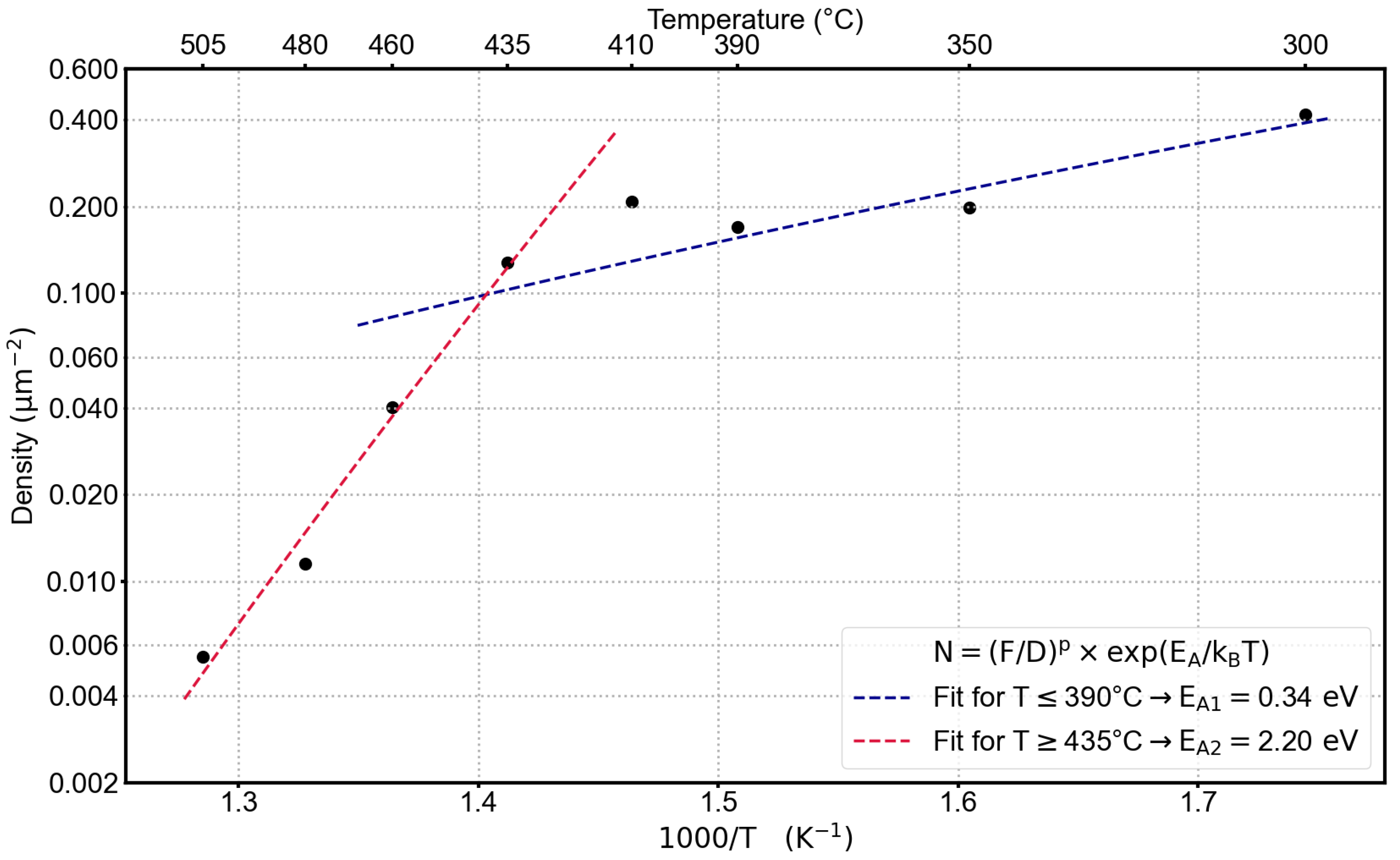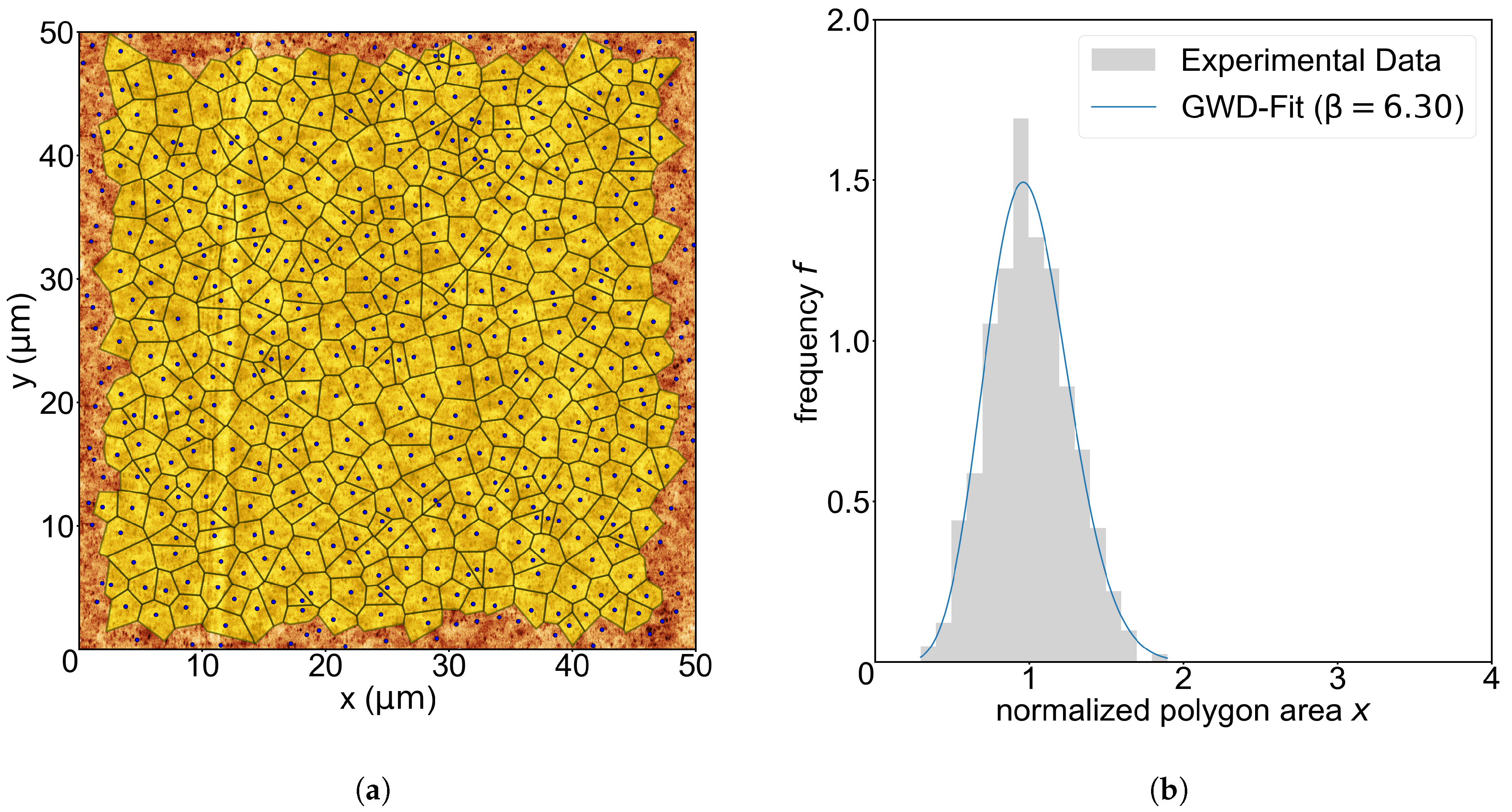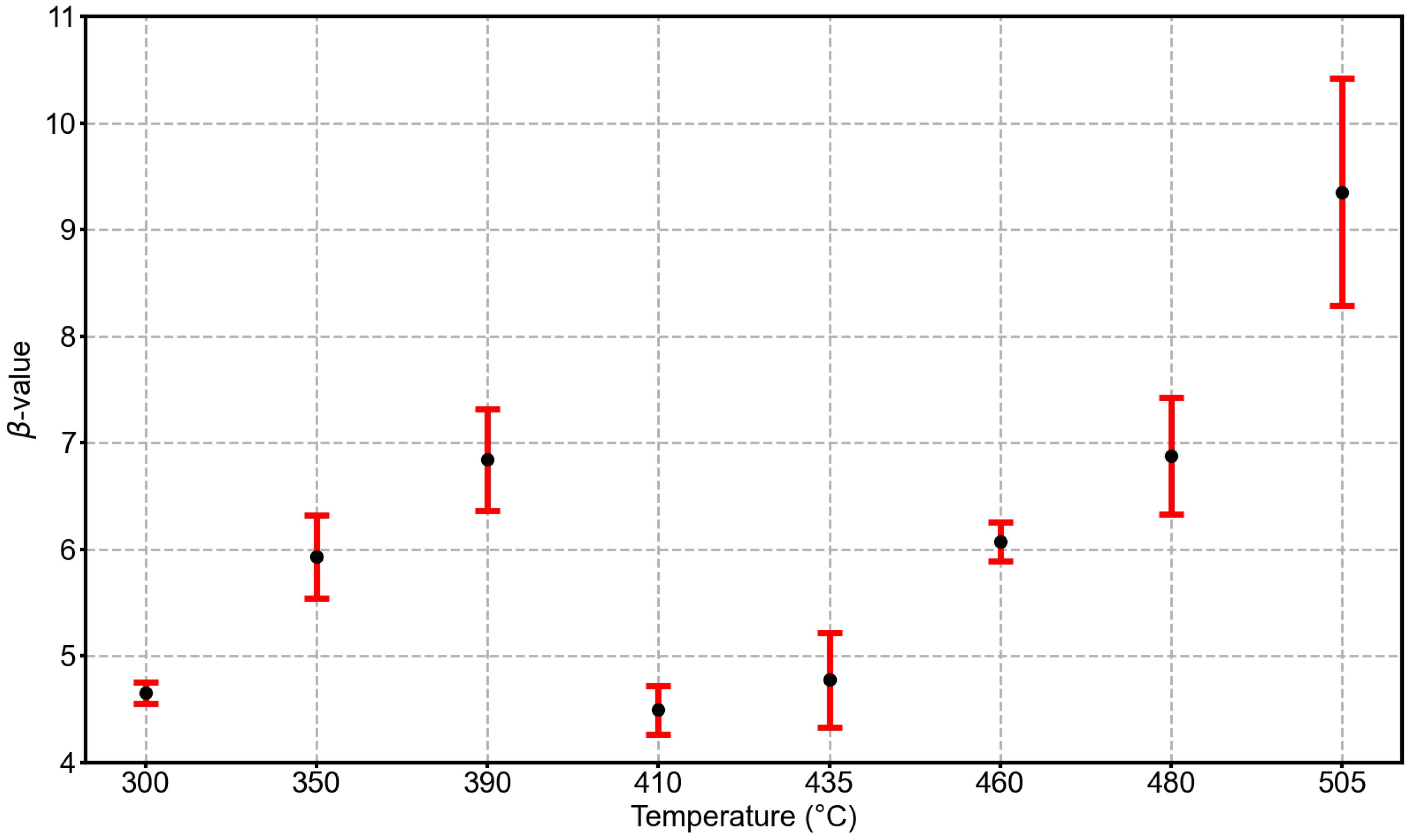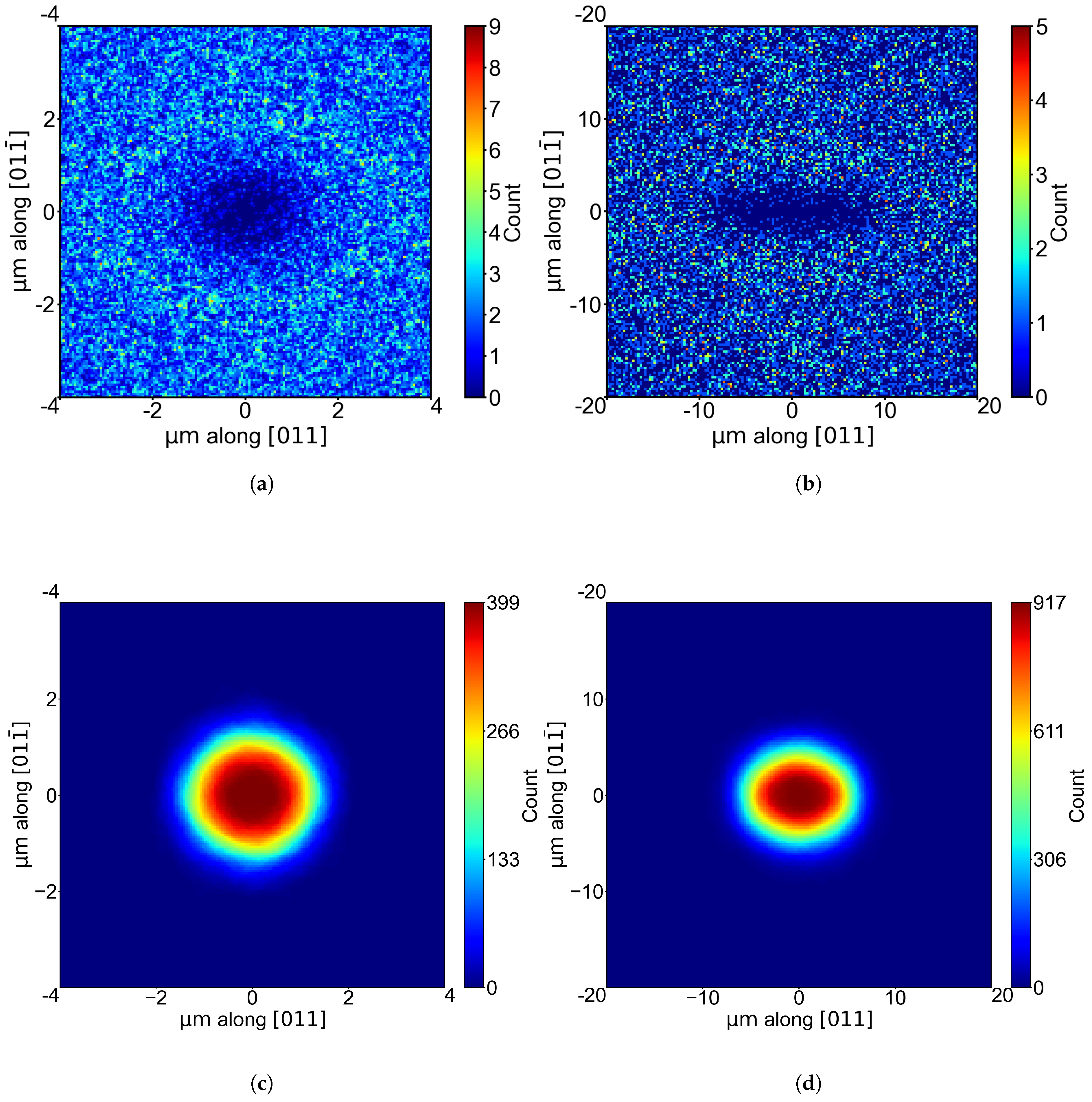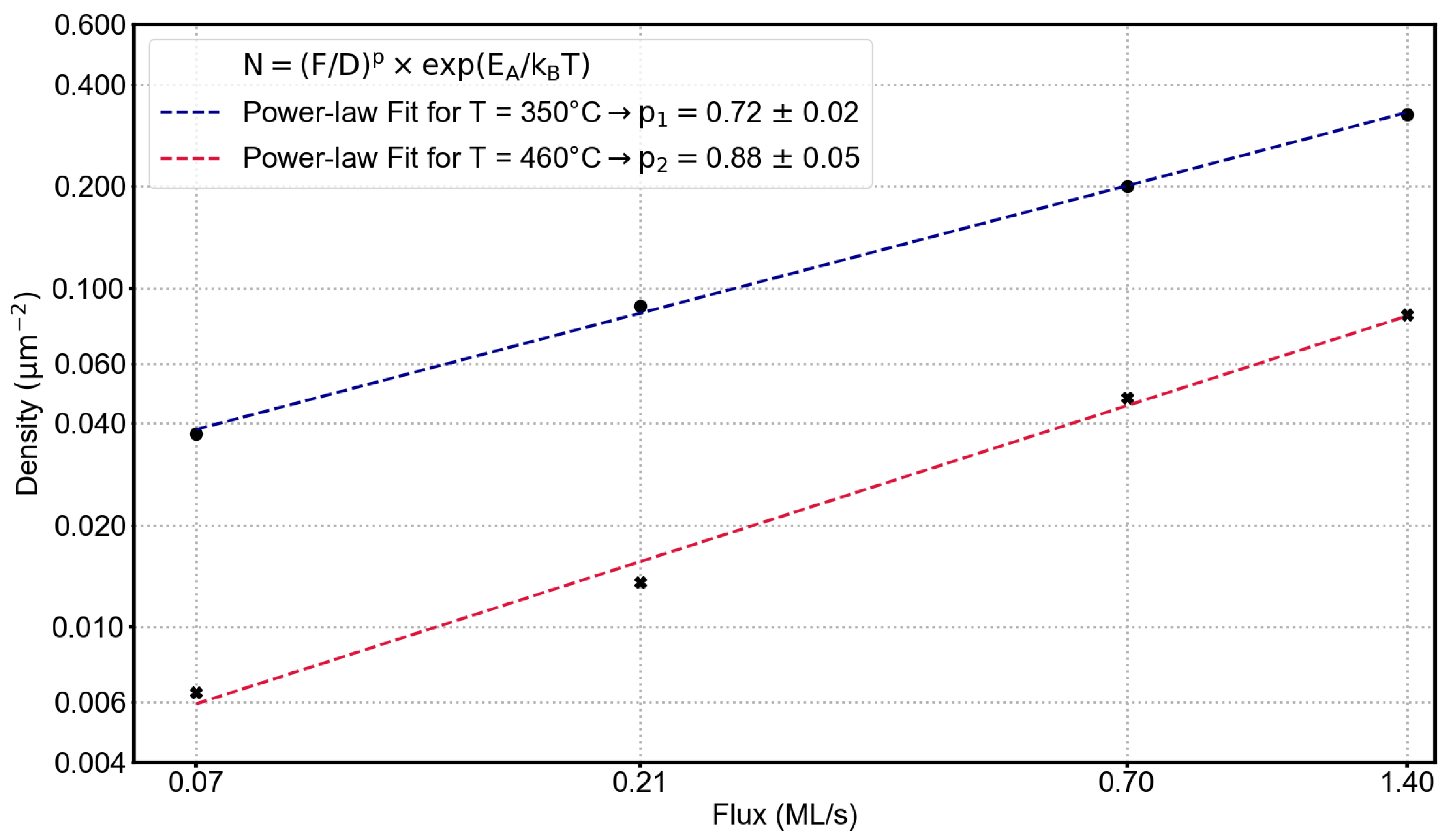1. Introduction
Semiconductor quantum dots (QDs) are prime candidates for the on-demand generation of single photons and entangled photon pairs, crucial processes for quantum information technologies [
1,
2]. In particular, local droplet-etched (LDE) QDs in the
system have shown very low fine-structure splitting [
3] due to the very good circular in-plane symmetry of the electron and hole wave functions, allowing for the generation of photon pairs with a high degree of polarization entanglement [
4]. To also achieve this for QDs that emit in the optical C band, one can try to transfer the process of LDE to the
system for QD generation. Cao et al. demonstrated LDE QDs in
layers [
5]. Deutsch and co-workers reported on the fabrication of droplet-etched
QDs in
layers, lattice-matched to InP, emitting in the optical C band [
6,
7]. In this paper, we analyze the spatial distribution of nanoholes in
layers etched by InAl droplets as in the latter.
The LDE process in molecular beam epitaxy (MBE) can be divided into two parts [
8,
9]: First, the group-III material is deposited under strongly reduced group-V flux. This results in the formation of metallic droplets on the surface. In the second step, these droplets etch nanometer-sized holes. Consequently, the final arrangement of the holes mirrors the distribution of the droplets before the etching started. The spatial distribution of droplets has already been analyzed by Tuktamyshev et al. [
10,
11] for Ga droplets on a GaAs(111)A vicinal surface. They employed nucleation theory [
12] to evaluate the droplets’ spatial distribution in their experiments. Although initially only intended for sub-monolayer coverage growth of islands, this approach describes their results reasonably well. In this contribution, we discuss a different material system—an on-axis surface, i.e., a system with no intrinsic anisotropy induced by steps—and, for the first time, a droplet that is composed of two different metals (In and Al). Following the approach proposed by Tuktamyshev and co-workers, we compare our results from the analysis of the nanoholes’ spatial distribution to predictions from the theoretical description of island nucleation and growth. Therefore, we discuss the relevant formulas briefly in the following paragraphs.
Standard mean-field nucleation theory [
13] predicts that the density (
N) of stable 2D islands formed by adatoms diffusing on a structureless substrate varies with temperature and flux as follows:
where
F is the atom flux onto the substrate,
D the adatom diffusivity,
is an activation energy containing the diffusion activation energy and the nucleation energy for a stable cluster,
the Boltzmann constant, and
T the substrate temperature. Furthermore,
is an exponent containing information about the adatom aggregation process given by the
parameter, where
i the critical size of the stable nucleus, i.e., the number of atoms that form a stable nucleus. Equation (
1) is an analytical solution for the case of sub-monolayer coverage, provided the island size distribution satisfies the scaling law:
where
is an ‘unknown’ distribution function that depends on the island size (
s), the average island size (
), and the critical coverage before island coalescence (
) [
12]. It must be mentioned that, for problems like diffusion and aggregation, scaling analysis, in general, only offers a qualitative description. However, the conceptual understanding gained from scaling is invaluable for interpreting and making sense of computer simulations and experimental results [
12].
Mulheran and Blackman [
14] have discussed the connection between island size scaling and the size distribution of the adatom capturing zones (CZs), i.e., the region of the surface from which emerging islands capture additional adatoms for their growth, with the assumption that the atoms from the material flux deposited onto the substrate instantly agglomerate to either form an island or diffuse to the nearest island, emptying the region in which every adatom is closer to the central island than to any other one. These CZs are often approximated by a Voronoi tessellation of the surface, a mathematical construct that creates regions in which any point is closer to its nucleus than to any other one on the surface [
15,
16,
17] by connecting the central nuclei to their nearest neighbors and drawing the perpendicular bisectors of each connecting line. These bisectors form a polygon around the central point, defining a Voronoi cell. Mulheran and Blackman also showed that the island size distribution follows the same distribution function as the CZ size distribution, i.e., one can investigate the Voronoi cell size distribution instead of the island size distribution. This is especially advantageous in cases where it is hard to determine the island size, e.g., for 3D islands or, in our case, a situation in which the original droplets vanished and only the resulting holes can be observed. A commonly—but not the only—employed scaling function for the Voronoi cell size distribution in thin-film growth is the generalized Wigner distribution (GWD) [
10,
11,
18,
19].
The GWD is given by
with the two
-dependent parameters of
and
,
, with
s being the area of a Voronoi cell,
being the average Voronoi cell area, and
Fitting the GWD and its only parameter (
) provides insight into the critical nucleus size if
is known. As pointed out, for example, by Pimpinelli and co-workers,
is related to the adatom aggregation of the islands, e.g.,
in the case of 2D diffusion and
for 1D diffusion [
12,
19]. These two cases have been observed experimentally for Ga droplets [
10,
11]. In fact, Pimpinelli and co-workers derived relations between
p and
i for different situations, e.g., two- and three-dimensional islands, fractal islands, and vicinal surfaces [
12]. Later, Pimpinelli introduced the
parameter to write the different relations in a compact form (Equation (
5)) [
19]; however, there is no deeper physical interpretation for the
parameter. Earlier, Kandel [
20] pointed out that the energy barriers at island edges might also play an important role in the island formation stage, leading to
. Furthermore, Pimpinelli states that
for restricted adatom diffusion, where
is a function of the concentration of blocking impurities [
19]. Nevertheless, without any a priori knowledge of the dominant process, information about
and
i can only be gained via cross-evaluation of two experimentally accessible datasets, e.g., the exponent (
p) (Equation (
2)) and the fit parameter (
) of the capture zone distribution (Equation (
6)). However, this approach is only valid if the critical coverage for coalescence itself is not a function of the island density (this might be the case for fractal clusters [
12], but it is not valid in our material system). Then, one finds
as has been stated by Pimpinelli et al. when analyzing pentacene molecules on sputter-amorphized mica surfaces [
19].
In this work, we investigate the spatial distribution of the nanoholes etched in In0.52Al0.38As layers by InAl droplets. We vary the etching temperature and material flux of the etchant and determine the spatial distribution from atomic force microscopy (AFM) images. We perform Voronoi tessellation of the images and determine the distribution function for the sizes of the Voronoi cells. In addition, we determine the density of the nanoholes as a function of temperature for a fixed flux, as well as for a varying fluxes at two selected temperatures. The analysis also includes a determination of the nanoholes’ nearest-neighbor distribution.
2. Materials and Methods
All samples were grown on semi-insulating InP(100) substrates from AXT (on-axis orientation better than 0.5° according to the manufacturer) in a standard solid-source MBE system, an Octoplus 500 from Dr. Eberl MBE-Komponenten GmbH, equipped with standard effusion cells for group-III elements and a valved cracker source for As. We do not believe that the small, unintentional miscut of the wafers plays any role in experimental observations because all anisotropies we observe are along a specific crystal direction. This seems very improbably induced by an unintentional miscut over several wafer batches.
The substrates were first heated to 540 °C for deoxidation—10 min under an
environment. Afterwards, the substrate temperature was lowered to 505 °C, and a 100 nm In
0.52Al
0.48As layer was grown at an
flux of
mbar, measured ∼40 mm above the wafer surface by a standard Bayard–Alpert ionization gauge. In the next step, the substrate temperature was lowered to the value at which droplet etching was performed (300–505 °C), and the
flux was reduced to
mbar. Then, the group-III shutters were opened briefly to deposit ∼1.4 ML InAl. This was followed by an etching step of 3 min, nd following that, the
flux was increased back to
mbar. Afterwards, the substrate temperature was increased again to 505 °C. At last, after waiting one minute for stabilization (usually, the holes are filled after this step), the sample was cooled down again and removed from the system. The ramp back to 505 °C is only included to exactly match our recipes for the full structure with QDs emitting at 1550 nm [
6]. The temperatures given throughout this paper were determined by band-edge thermometry using a BandiT system from ksA. More details on the fabrication process of the nanoholes can be found in [
6,
7].
The droplet-etched holes were investigated by AFM, employing a Bruker Icon Dimension XR SPM. The center coordinates of the individual holes were determined from the AFM images, employing the open-source software Gwyddion [
21]. Based on these coordinates, the density of the holes, the direction in which the nearest neighbor occurs, the Voronoi tessellation, and all consecutive calculations were carried out by employing Python code. We scanned regions of different sizes, depending on the hole density, with a resolution of 2048 × 2048 pixels and a scan time of 2 s per line (∼80 min per image). For each density, we analyzed multiple images to obtain significant statistical relevance. The exact details can be found in
Table 1.
3. Results and Discussion
First, we analyzed the hole density as a function of the etching temperature for a constant InAl flux of 0.7 ML/s in an Arrhenius-like manner. As can be seen in
Figure 1, we observe two regimes in which the exponential dependence from Equation (
1) can be fitted quite well by a linear regression on the logarithmic density values, albeit with two significantly different slopes. This corresponds to different activation energies for the two temperature ranges: from 300 °C up to ca. 390 °C, an activation energy of
eV is found, whereas for the high-temperature regime (ca. 435 °C to 505 °C), the temperature dependence is much stronger with
eV. This change in activation energy is a clear indication that the mechanism of droplet aggregation is different in these two temperature regimes.
When analyzing the AFM images, we did not observe any evidence for different droplet types over the entire temperature range that we investigated, i.e., no indication of a separation into pure In and Al droplets. Different droplet types would manifest themselves in different types of nanoholes, e.g., with different depths and diameters, as shown in [
7]. Therefore, we assume that the ones in our experiments are InAl droplets with the same composition as the flux ratio (52% In content) but cannot exclude slight variations of the droplet composition. Of course, In and Al atoms will show different surface diffusion and binding energies in a few-atom island, i.e., the critical nucleus size depends on the exact composition. Therefore, one has to interpret results of comparisons with nucleation theory with some precaution because the theory takes only one material type into account. The results, e.g., the activation energies or the critical nucleus size, can be interpreted as an average value.
To get more insight into the aggregation process, we analyzed the CZ distribution of the InAl droplets by applying Voronoi tessellations to our AFM images as discussed in
Section 1. We determined the
parameter for all AFM images by fitting the GWD (Equation (
4)) to the Voronoi cell size distribution. An exemplary Voronoi tessellation superimposed on the AFM image of the sample with an etching temperature of 350 °C is shown in
Figure 2a. In
Figure 2b, the corresponding distribution of Voronoi cell sizes and the best fit using the GWD function from Equation (
5) are shown.
From the set of
parameters at a given etching temperature, we calculate the average value and its standard error. The
values and their error as function of temperature are shown in
Figure 3. As seen before, differences between the two temperature regions can be observed, as shown in
Figure 1. The value of
monotonically increases in the low-temperature region from ∼5 at 300 °C to ∼7 at 390 °C. For a substrate temperature of 410 °C,
drops to a value of ∼4, then starts to monotonically increase again in the high-temperature region to a value of ∼9 at 505 °C. An increasing value of
corresponds to a narrowing of the Voronoi cell size distribution. A narrowing distribution with increasing temperature seems to be reasonable because the adatom diffusion length generally increases with increasing temperature and Ostwald ripening becomes more relevant with increasing temperature [
22]. However, we do not observe a monotonic increase over the whole temperature range, as expected from such a ripening process; instead, two temperature regions monotonically increase, with a rather abrupt drop to a lower
-value around 410 °C. The temperature at which the sudden drop in
appears corresponds to the temperature at which the activation energy (
) changes (see
Figure 1).
Neither the hole density nor the size distribution of the CZs contains any directional information. To elaborate on this, we investigated both the distribution of the nearest nanoholes and the average shape of the Voronoi cells. For the nearest-neighbor distribution, we repositioned each hole in an AFM image to the origin (
) and mapped the relative coordinates of all other holes as in [
10,
11]. Then, we aggregated the data from all AFM images at a given temperature and displayed them in a 2D histogram so that each pixel represents the number of holes at these coordinates. Basically, those 2D histograms visualize the spatial distribution of the frequency of nearest-neighbor occurrences.
Figure 4 displays the resulting exemplary histograms for etching temperatures of (a) 350 °C (low-temperature regime, ∼0.2 holes/μm
2) and (b) 480 °C (high-temperature regime, ∼0.02 holes/μm
2).
As expected, the zone without nearest neighbors is significantly larger for the experiment at the higher temperature due to the much lower density. Notably, we observe a pronounced elongation of the denuded zone along the [011] direction for 480 °C, whereas the denuded zone is nearly circular in shape at 350 °C. The 2D histograms for the other temperatures show the same tendency: We observe a nearly isotropic denuded zone in the low-temperature regime below 410 °C, whereas the denuded zone in the high-temperature regime above 410 °C is strongly anisotropic, with an elongation along [011]. Please note that these temperature regimes also agree with the two ranges for which we find the two different activation energies (see
Figure 1). To support our findings, we also investigated the average shape of the Voronoi cells by shifting all holes with their corresponding Voronoi cell to the center of the image. The number of Voronoi cells overlapping on a pixel is color-coded. In
Figure 4c,d, the 2D histograms for 350 °C and 480 °C are shown. The same behavior regarding the elongation along [011] as in the nearest-neighbor distribution is observed. The elongation at high temperatures is not as pronounced, but this is expected because many Voronoi cells with different shapes are superimposed. Interestingly, an elongation along [011] is also observed in the shape of the individual holes for the high-temperature region [
6,
7]. However, this does not necessarily have to be caused by elliptically shaped droplets or the adatom agglomeration process but may be due to an anisotropy in the etching process.
Our observations clearly point towards a change in the adatom agglomeration process when going from the low-temperature to the high-temperature regime. According to nucleation theory, this should be reflected in the
parameter (see Equations (
2) and (
5)). To also exploit Equation (
2) for the determination of
, we performed flux-dependent depositions at 350 °C (low-temperature regime) and 460 °C (high-temperature regime). In
Figure 5, a double-logarithmic plot of the hole density as a function of the InAl flux is shown. The power-law behavior predicted by Equation (
2) is evident, and by fitting the experimental data, we obtain a value for the exponent (
p) at the two deposition temperatures. With the corresponding
values determined earlier (
Figure 3), we can now determine
and
i by calculating
i according to Equation (
6) and solving Equation (
2) or (
5) for
. Our results for
,
p, and the corresponding values for
i and
are summarized in
Table 2.
The
parameter changes from ∼0.93 at 350 °C to ∼0.73 at 460 °C, while the critical size of the nucleus does not appear to change significantly. It seems that the transition between the low-temperature and high-temperature regime does not coincide with a significant change in the critical nucleus size. The interpretation of
is not straightforward: For dominating 2D diffusion,
should be 1, whereas it should be 2 for 1D diffusion. However, we observe values smaller than 1, which indicates that the processes of attachment to the islands play a role [
19,
20]. We do not want to overstretch the interpretation of
because we think that Ostwald ripening plays a role in our experiments, which is not included in the aforementioned nucleation theories from which
emerged. They are strictly applicable only under specific conditions, e.g., instantaneous nucleation and low coverage. For all the equations given in
Section 1, ripening is not included. However, Brune [
22] states that Ostwald ripening might be relevant for metal clusters if
. He also points out that Ostwald ripening results in a narrower island size distribution with increasing temperature, as mentioned earlier when discussing the changes in the
parameter. We find
, and we also clearly observe a narrowing of the Voronoi cell size distribution. This indicates that Ostwald ripening might, in fact, play a role in our experiments. However, if such ripening is the only important factor, we would not observe the different adatom aggregation behaviors in the two temperature regimes, i.e., the significantly different activation energies, the drop in the
values around the transition temperature between the low- and high-temperature regimes, and the change in the denuded zone’s shape around the holes. For textbook Ostwald ripening, we would expect a monotonic temperature dependence. Therefore, a second effect must play a role. We speculate that this might be a change in the surface reconstruction around the transition temperature of 410 °C between the low- and high-temperature regimes. We propose that in the high-temperature regime, the reconstruction is more anisotropic. Although we could not verify this experimentally due to the lack of a suitable RHEED system in our MBE, the proposal seems to be reasonable. For example, Kim [
23] investigated the formation of Ga droplets on GaAs surfaces and pointed out that the reconstruction of the surface will, in general, change from an As-rich to a Ga-rich surface reconstruction in the first phase of the deposition in the droplet formation stage. So, the metal-rich surface reconstruction is relevant for the droplet formation process. Stevens and co-workers [
24] also found a change in the In diffusion behavior that coincides with a change in the surface reconstruction when investigating the crystallization behavior of In droplets on In
0.53Ga
0.47As, a material system that is very similar to ours, which could therefore exhibit a similar surface reconstruction. They also discussed the variation of activation energies for different material systems, for different temperature ranges, and for different experimental methods. This supports our idea that a change in the surface reconstruction is responsible for the two different adatom agglomeration behaviors in low- and high-temperature droplet formation.
